[Updated post-event to annotate this list with notes about last-minute changes to gear/food and also to comment on what worked well and what, in hindsight, I would do differently.]
From May 14 – 20, I’ll be one of 72 competitors, who hail from 20 countries*, embarking on the inaugural Mauna to Mauna Ultra adventure—a six-stage, self-supported, 155-mile race that crisscrosses the Big Island of Hawaii.
As I did when I ran the Grand to Grand Ultra in 2012 and 2014, I’m publishing a gear and food list for those stage racers who may want to learn about the gear and caloric combination that I recommend. Additionally, this list may be useful for anyone interested in fastpacking (i.e. lightweight, faster-paced backpacking).
(*The participants’ countries: Australia, Canada, Denmark, France, Ireland, Israel, Italy, Japan, Lebanon, New Zealand, Poland, Portugal, South Korea, Spain, Sweden, Switzerland, Taiwan, UK, USA, Wales. The international aspect of this type of stage racing is one of the many special things about it.)
First, some context:
How to Learn About Stage Racing and Follow the Mauna To Mauna Ultra
- Basic info about the event is available through its website. To follow updates on the race during the week of May 14, I suggest you like the event’s Facebook page and also follow my FB and/or my twitter @sarahrunning because my sister will post updates to my accounts. (The participants will have access to shared computers for a limited time at camp each afternoon, on which we can send an outgoing email, so each day I’ll try to bang out a couple of paragraphs about how the day went, for my sister to share.)
- For background on training and racing this type of stage race, I invite you to check out the archived articles in this category on my blog and read a recent Trail Runner article I wrote, “Five Ways to Know If a Stage Race Is For You.”
- Please check out my last post if you’re interested in my training and also the campaign I’m running to raise awareness and support for the nonprofit Free To Run.
I don’t know the Mauna to Mauna’s exact route, because the day’s route is revealed on the morning of each stage, but I can share the description and elevation profile published on the website:
Participants will encounter a mix of terrain, including trails through lush rainforest, rugged lava trails, mountain climbs (not technical), open grassland, river crossings, coastal beach trails and sand. The starting line is at sea level on Coconut Island off the east coast of Hawaii Island. Camp 1, which is your campsite on the evening before the start of the race, is situated close to the crater of Kilauea at an altitude of almost 4,000ft (1,219m). The finish line is on the west coast of Hawaii Island. … Since Hawaii Island possesses 11 of the world’s 13 climate zones, be prepared for extreme changes in weather throughout the week of the race. You will experience most of these climates from wet-tropical to cool temperate to arid.
Post-race update: The course changed significantly in the final weeks before the event; find out more about these changes in related race report and UltraRunnerPodcast interview. Instead of gaining approx 16,000 feet total elevation, the course we ran gained over 22,000 feet. The long stage (48 miles between Camps 4 and 5) ended up being a lot more challenging than this profile below suggests.
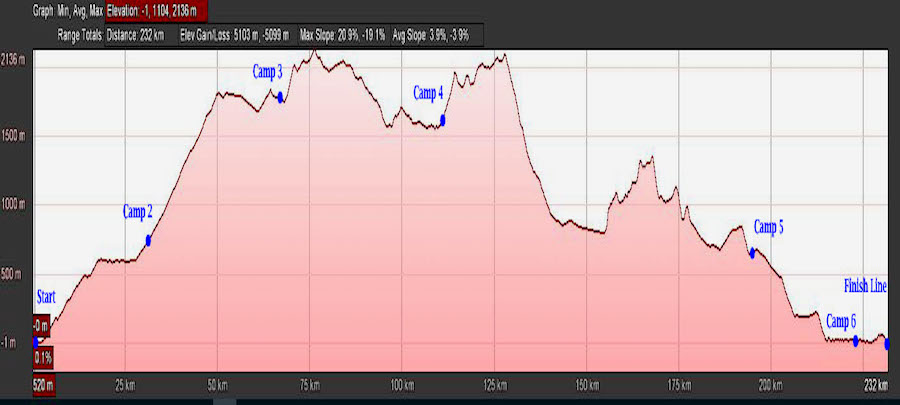
Elevation profile for the Mauna to Mauna Ultra, showing 5103 meters (16,742 feet) elevation gain and roughly the same amount of descent.
The event divides the mileage the following way (although this, like the elevation profile, is subject to change; we haven’t received a final race briefing about any route changes, which are always a possibility—especially in a first-year event).
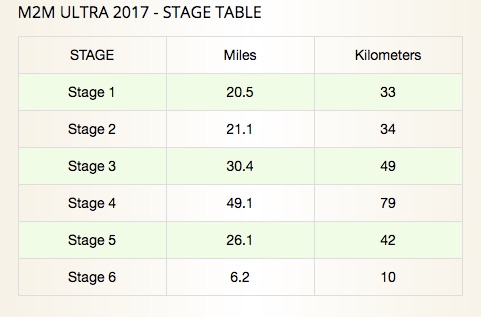
Post-race update: The mileage for the six stages ended up being: 26.7, 19.1, 28, 48, 29.1, 5.
So, What Am I Bringing To Get Through the Race?
Glad you asked :-). Obviously, it behooves competitors to carry as little as possible, because every pound of weight slows us down and saps energy. But, given the climate and terrain variability, I can’t go too light or get too hungry from lack of food. I’ll take a couple more pieces of clothing than I did during the Grand to Grand Ultra, because I anticipate being wet almost the entire time (from rain showers and sweat, and stuff won’t dry out due to humidity), and then I’ll need dry layers to stay warm at the higher-elevation camps.
After much deliberation, I narrowed the contents to the following. Remember, participants are entirely responsible for their food, clothing and gear during the week; the race only provides water, hot water at camp (so we don’t need to pack a stove), communal tents, and electrolyte pills (which I prefer not to take, so I’m getting adequate electrolytes from my food supply). If I forget something, or if I don’t pack enough food and feel weak from calorie depletion, that’s my problem; I will have no access to any extra supplies during the week, except some medical supplies from the team doctors in case of emergencies.
(The medical briefing we received mentioned dangers such as poisonous centipedes, wild pigs, and a virus carried by animal urine that may be present in the puddles we run through, which can infect open blisters on our feet … yikes! Previously, I thought all I really had to worry about was cutting myself on sharp lava rock.)
My pack, with both containers full of water (the water weighs 2.4 pounds) totals 20.5 pounds. It will lighten up each day as I eat through the food supply.
Food
For most of the stages, I have 2300 – 2400 calories, except on the final stage when I’ll be down to 840 calories for breakfast and snacks while running; on the last day, we have just a 6-mile “sprint” to finish by lunchtime. My calories total 14,850 for the week (14,000 is the required minimum). This is slightly less than I brought to the Grand to Grand, but I feel I’m more fit and experienced now and need slightly less based on my training. Lord, I hope that sentence doesn’t come back to haunt me!
I tried to pack a good balance of macronutrients (complex carbs, protein, fat), a lot of electrolytes given how much I’ll be sweating (salty foods, and electrolytes in the drink mixes and gels), and enough but not too much quick-burning simple carbs to prevent bonking (gels, chews, drink mix).
A typical day’s food: ProBar (360 cals) for breakfast, along with a packet of instant coffee and hot cocoa mix (100 cals) to make a mocha; food to eat on the trail (the equivalent of “lunch”): VFuel drink mix (200), 1/2 cup trail mix (280), a mix of Honey Stinger and Clif Block gels (170), one or two VFuel gels (100 ea) depending on the stage, a Honey Stinger Waffle (160). Food for late-afternoon recovery at camp: a packet of almond butter (190) and a packet of Gu Recovery Drink (190). Dinner: a dehydrated backpacker meal (the ones I brought range from 560 – 620 cals each).
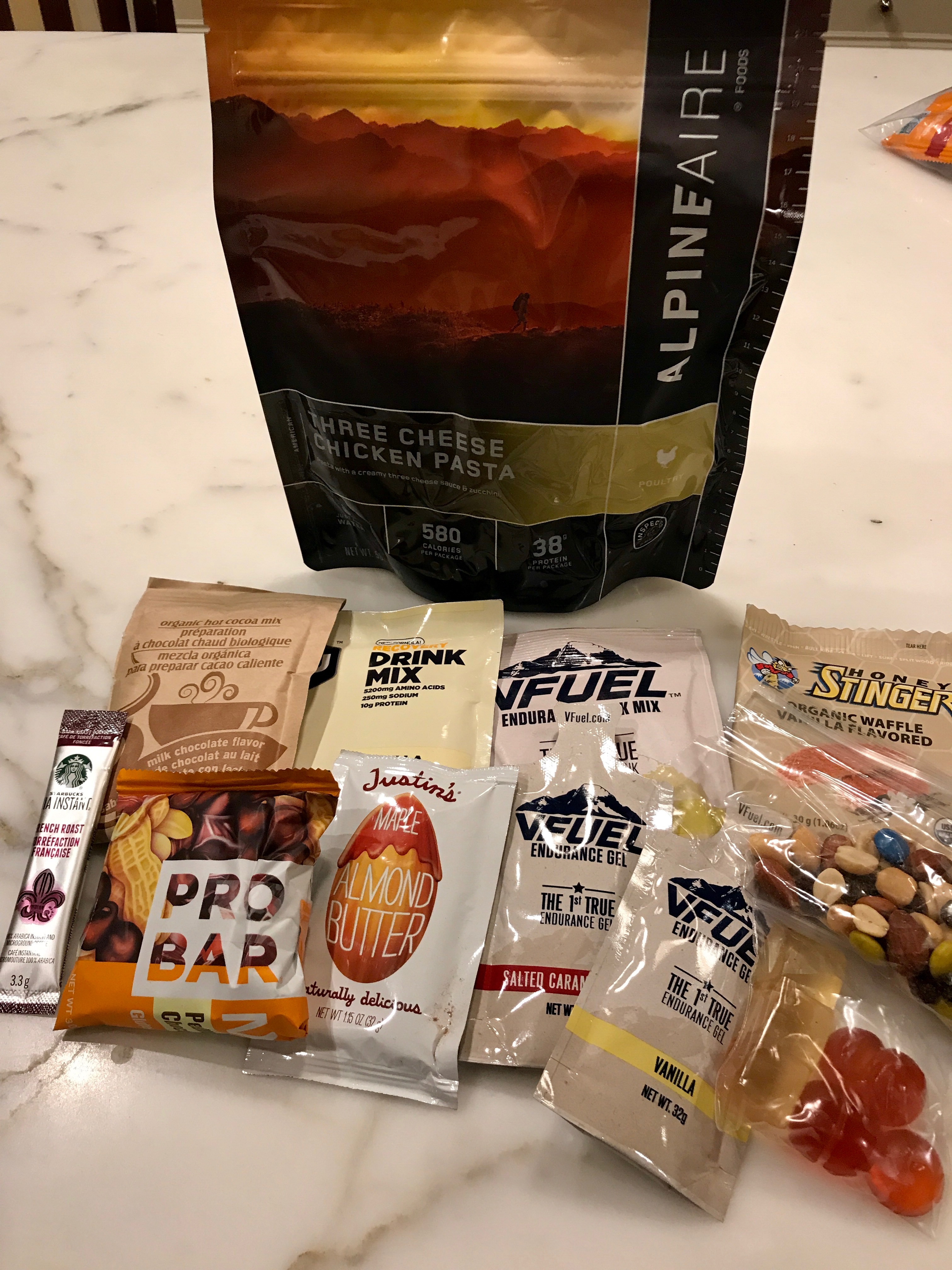
Stage 2’s food supply: 2440 calories. Stage 2 is 21 miles, and from the elevation profile, it appears we will climb at least 3000 feet uphill that day.
I have one extra-hefty mac & cheese meal for midweek that’s 960 calories. I also have a special treat for midweek of vacuum-packed smoked salmon (140 cals). I’m packing extra trail food for Stage 4 (the long 49-mile stage), and then the day after that—when we have a non-running recovery day—I have a different menu for variety and recovery (e.g. freeze-dried granola with milk & berries, 620 cals, for breakfast in lieu of a ProBar).
Here’s how all the food looks when rationed into baggies. I will squeeze the air out of these baggies, and use masking tape to make them as compact as possible, before putting them in my pack.
Post-race update on food: It turns out, I would have brought more calories and in different form. The course was more difficult than anticipated due to cold, wet weather in first three stages, and high altitude and cold in long stage. I felt hungrier and more bonky than I should have, especially on the long stage. For that high-altitude long stage, I wish I had packed more liquid calories such as more packets of VFuel drink mix, and then soup with ramen noodles for nighttime (when the checkpoints provide hot water). It was difficult to eat the bars and trail mix I brought because I was breathing so hard in the high altitude, and racing so hard competitively, and my mouth was very dry. See more details in the related race report. I also would have packed more fattier nuts, like macademia and cashews, rather than only the almonds I brought. Overall, however, I was happy with the dehydrated meals and the breakfast choice.
Gear
(* denotes mandatory equipment)
* backpack: Ultimate Direction 30L Fastpack, 24.8 oz. I went with this choice because the roll-top design, like a dry bag, allows for more capacity, and then I can cinch it down as I eat through the food and the contents reduce. Post-race note: I ended up liking this pack and would recommend it. Ultimate Direction has a new version with a removable waist belt that some people might like.
* water containers: 1 Ultimate Direction 20oz Classic water bottle, 1 Ultimate Direction Flexform 600L bottle, and 1 Ultimate Direction Body Bottle 500ml. I have a variety of bottles because I want the classic for use around camp (I like how it stands up), I like the way the Flexform one feels, and the soft, collapsible Body Bottle is an extra that I can fill only if and when I need extra fluid between checkpoints. Post- race note: I did not need the third collapsible Body Bottle. The two water bottles were enough.
* sleeping bag: Mont-Bell Ultra Light Super Spiral Down Hugger #3 (I purchased it in 2012 for my first stage race, and it’s held up great; I don’t see it for sale online anymore), 21 oz.; plus, Sea to Summit brand 6.5L waterproof compression sack for it.
* sleeping pad: Kylmit Inertia X Frame (I also got this in 2012 for my first stage race, and it’s worked great; I can’t find it for sale online anymore.)
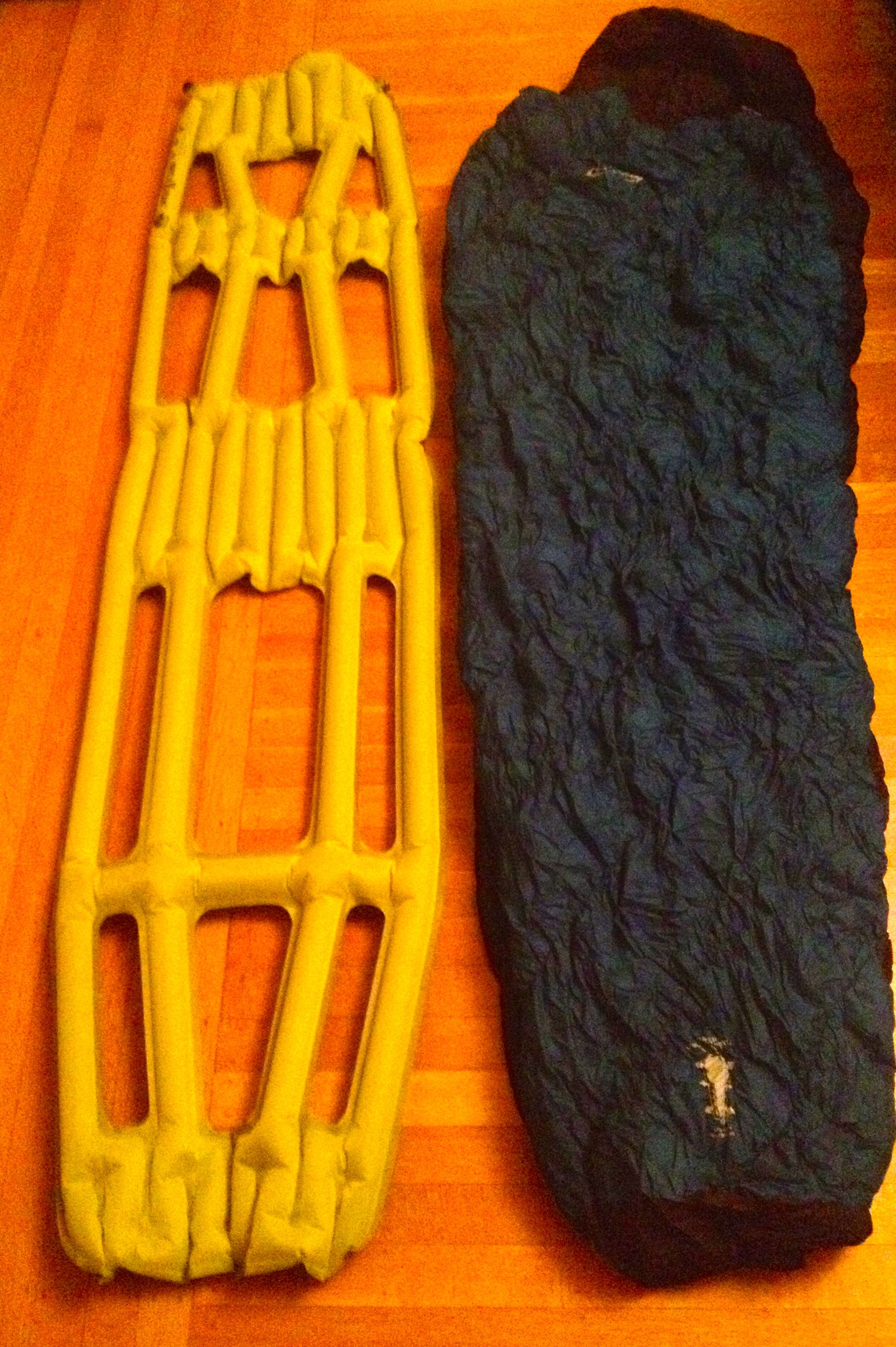
My super-light inflatable pad, which I put inside the ultralight sleeping bag to sleep on. It provides just enough padding under my hips and head, but it means I have to sleep on my back for comfort, rather than on my side.
* pack rain cover: Ultra-Sil Pack Cover Post-race note: I screwed up by not testing this beforehand. It was too big and floppy for my pack; others had tight-fitting pack covers that worked better. But my pack cover ended up being a handy thing to sit on and to keep my stuff in to stay dry when everything was so wet, even inside our tent, from the heavy rain.
* compass (also has a built-in thermometer)
* knife
* signal mirror
* whistle
* space blanket
* two headlamps: I’m using 1 Black Diamond Spot, and in lieu of a second headlamp, my favorite lightweight flashlight, the Fenix PD32
. I like a combo of headlamp and hand-held flashlight for nighttime running.
* red flashing light (to go on back of pack during nighttime long stage)
Amphipod Pouch Post-race update: I ended up not taking this; I found it annoying to deal with while fastening my sternum strap, and I didn’t really need that pocket space after all. that attaches to pack’s sternum strap (provides a small pocket where I’ll carry the race map and other small items)
spork and collapsable plastic bowl for meals lightweight camping mug. At the last minute, I decided to pack the mug instead of the bowl (which is shown in the photo below), because I have room in my pack; I want the “luxury” of enjoying my morning mocha in a real mug, not a plastic-tasting bowl!
small roll of duct tape (to repair torn pack zipper or hole in gear, for example)
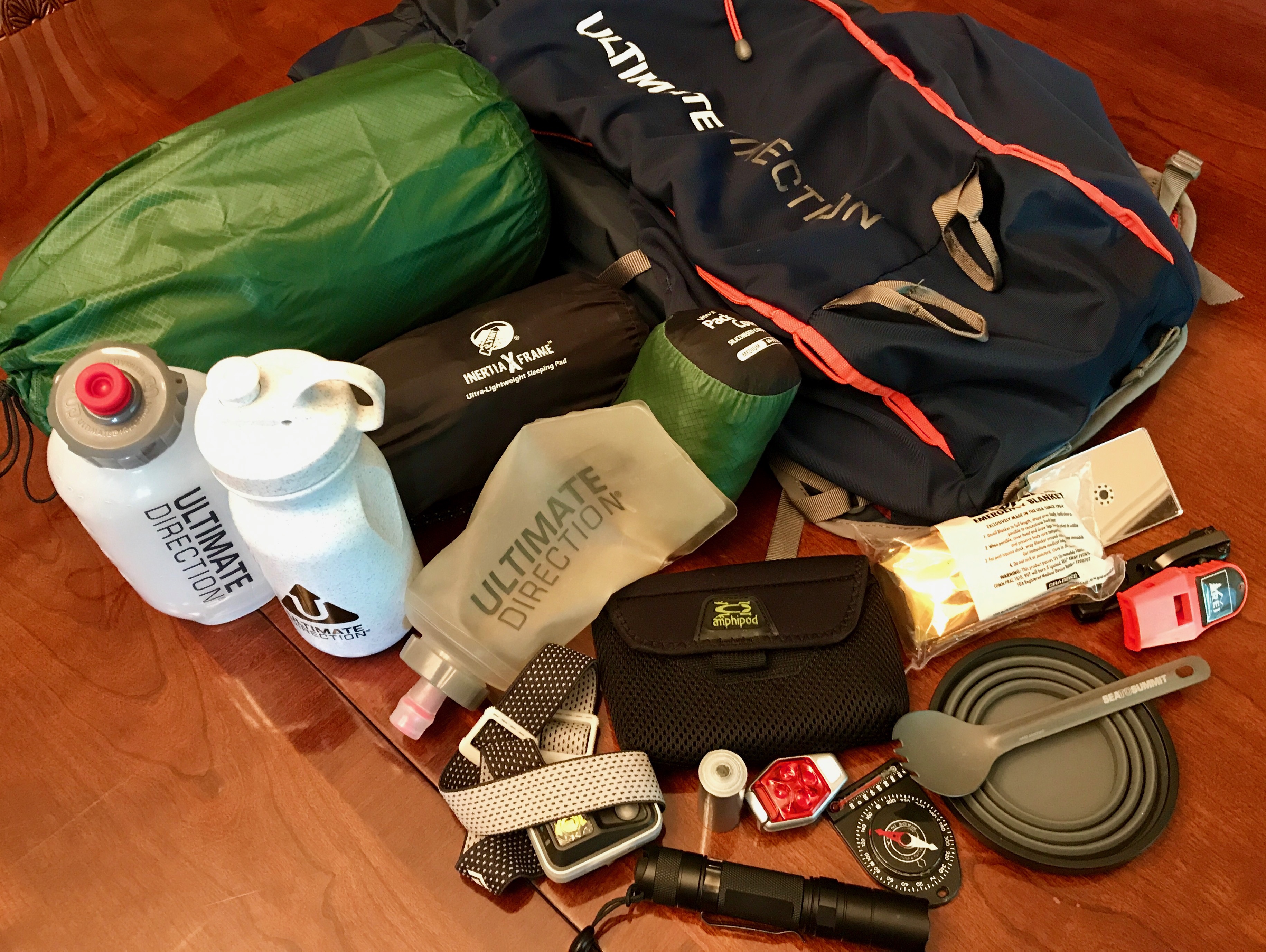
All my gear for sleeping, safety, hydration and eating.
Clothing
Post-race update: I had forgotten about—and then remembered—a good stage-racing trick, and that is: Bring a “disposable”outfit to wear to the first night’s camp (where you stay before the race starts the next morning), so that you can wear comfortable old clothes and then put your race outfit on fresh the first morning when Stage 1 starts. I wore a shirt and comfy old yoga pants. Then, I decided not to dispose of this shirt or the yoga pants; given the rain and cold we encountered, I was grateful for these extra layers. Also, I carried extra food with me from the hotel to the first night’s camp—an apple and extra bar—so I had that to eat on the first morning, which was useful.
(* denotes mandatory clothing layers for safety)
The basic outfit I’ll wear daily while on the course:
rabbit “hopper” style shorts
Salomon short-sleeve shirt made of their “Advanced Skin Active Dry” fabric
* country patch (USA flag) sewn on sleeve
bra: Instead of a regular sports bra, I’m going with an ultra-thin option, a simple “bralette” from Gap Body. I realized this is a good option because I’ll likely be wet most of the time (from sweat/humidity and rain), and I don’t want a thick-fabric bra that never dries out and feels horrible to put back on in the morning when damp. Plus, wearing a backpack eliminates almost all my chest bounce because of the pack’s straps, so I don’t really much bra support. post-race note: this bra choice ended up working really well and was comfortable.
hat
sunglasses
Buff for neck
socks (my favorite: Drymax Trail Running 1/4 Crew High Turn Down Socks) Post-race note: I ended up bringing three pair of socks and was grateful for each one; they got soaked and muddy in the rain, so I was glad to put on a new pair midweek. Then, I kept the third extra pair to wear at night so I’d have dry, clean socks at camp to keep my feet warm. I used this third pair in the final two stages.
Hoka Challenger 3 shoes Post-race note: These are an excellent choice for this event. You want thick, cushioned, sturdy shoes because of the miles of sharp rocks that the course traverses. Participants who wore thinner-soled shoes regretted it, because they really felt the rocks.
simple watch (showing time of day, not GPS enabled)
Extra layers for rain protection and warmth, and comfort items for camp:
* lightweight down jacket: Sierra Designs Gnar Lite (I’ve had this for several years and not sure Sierra Designs makes it anymore)
* water-resistant rain jacket: Ultimate Direction Women’s Marathon Shell. This is my favorite water-repellant windbreaker and weighs next to nothing.
* poncho: cheap one that’s a thin layer of plastic. Update: I just bought a second one now that I’m here in Hawaii and realizing how much rain we’ll encounter. One of these plastic ponchos likely will rip and fall apart after a couple days’ use, so I bought a second one. They weigh almost nothing, but the layer of plastic provides significant protection from rain and wind. Post-race update: I ended up needing and using both ponchos!
arm sleeves that provide both warmth and sun protection
base layer of long underwear and long-sleeve wool top to sleep in (I’m expecting it to be pretty cold at nighttime at two of the higher-elevation camps)
gloves Post-race update: I was grateful for gloves given the cold nighttime temperature of the long stage. Many participants grew dangerously chilled during the first three stages.
underwear for camp
one extra pair of Drymax socks, thinner and lighter weight than my main pair (see note above re socks)
Ooofos flip-flops: These are my big luxury item, and so worth it! In the 2012 Grand to Grand Ultra, I forgot to pack flip-flops for camp and realized they’re essential because you need to clean and air out your blistered feet after running all day. For the 2014 G2G, I packed super thin, cheap flip-flops. This time, I’m making room in my pack for lightweight yet bulkier flip-flops by Oofos because they feel so good and provide arch support. Additionally, I’m concerned that we will be camping around sharp lava rock, so I want thicker soles to avoid cutting my bare feet. These sandals fit well in the outer mesh pocket of my pack, as I discovered during the Diablo 50K, which I ran on April 15 with a fully loaded pack to practice. (I pinned on that sign to deal with the inevitable “What’s in your pack and why are you carrying it?” questions from others in the race.) Post-race note: These Oofos flip-flops were a godsend, and I highly recommend them.
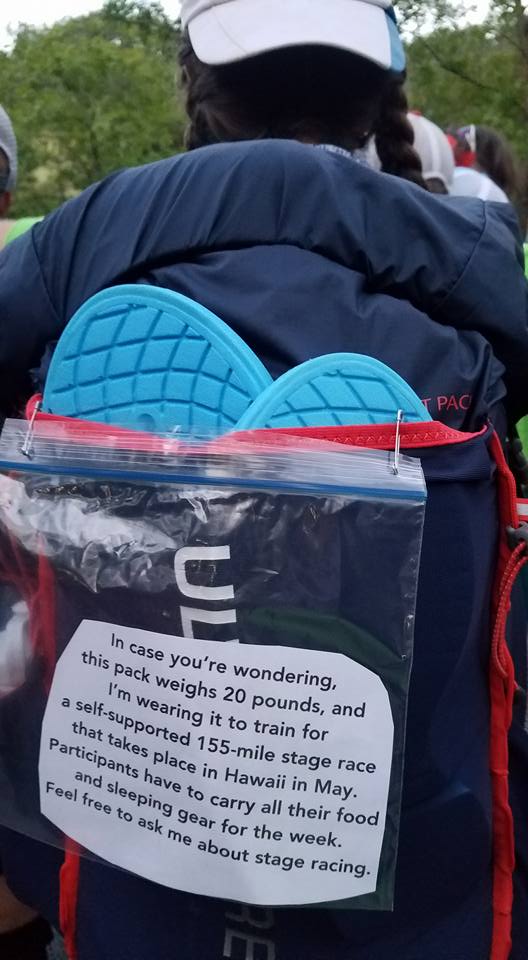
My pack, with the flip-flops in the outer pocket, and a handy explanatory sign at the April 15 Diablo 50K.
Toiletries and Misc.
mini tubes of sunscreen, Aquaphor, regular lotion, toothpaste
compact toothbrush
earplugs (I’ll share a tent with seven others; chances are, at least one will snore!)
small plastic comb and hairbands
3 spare AAA batteries for my headlamp
mini baggie with easy-access first aid to carry in pocket while running: a couple of BandAids, alcohol wipes, safety pin to pop blisters, a strip of fabric tape for pack chafing, an Aleve, some Tums for nausea; self-adhesive bandage for ankle wrap (in case of rolled ankle)
more substantial blister & med kit to use at camp: nail clipper, mini surgical scissors for cutting tape, alcohol wipes, two types of tape (one for blisters, one for chafed spots), needle for popping blisters; meds: Imodium, Aleve, emergency antibiotics
Trail Toes: my favorite anti-friction lube, created by stage-racing pro Vincent Antunez, whom I met at the 2012 Grand to Grand Ultra
and who’ll be at Mauna to Mauna Ultra. Buy this stuff, it works great! Update: Sadly, Vince can’t make it to the M2M. A US Army Major and physician assistant, Vince is in service to his country on a mission (I won’t reveal where, but suffice to say it’s a lot less desirable than being Hawaii), and he can’t get away to participate in this event. I greatly appreciate his service, and his sponsorship of the Grand to Grand and Mauna to Mauna events, and I encourage people to try his product and learn more through the website.
toilet paper in a baggie
ballpoint pen and mini composition book to take notes
iPhone: I will keep it turned off, in a baggie for water protection, buried in my pack, to use only occasionally in “Airplane mode” to save battery life and take photos; and, so I can contact my family at the finish line.
talisman: a one-inch-square carved stone buffalo that my brother and sister-in-law gave me before the 2012 Grand to Grand Ultra with the note, “The Zuni were an ancient people who lived in the area through which you’ll be running on the G2G. They had talismans—’fetishes’—that represented different values. This buffalo was meant to symbolize endurance to overcome, and was a provider of great emotional courage to those who possessed it.” I suppose for this island race I should have found a talisman that has to do with Pele, the Hawaiian goddess of fire, but this charm got me through the prior stage races so it’s coming to the Big Island!
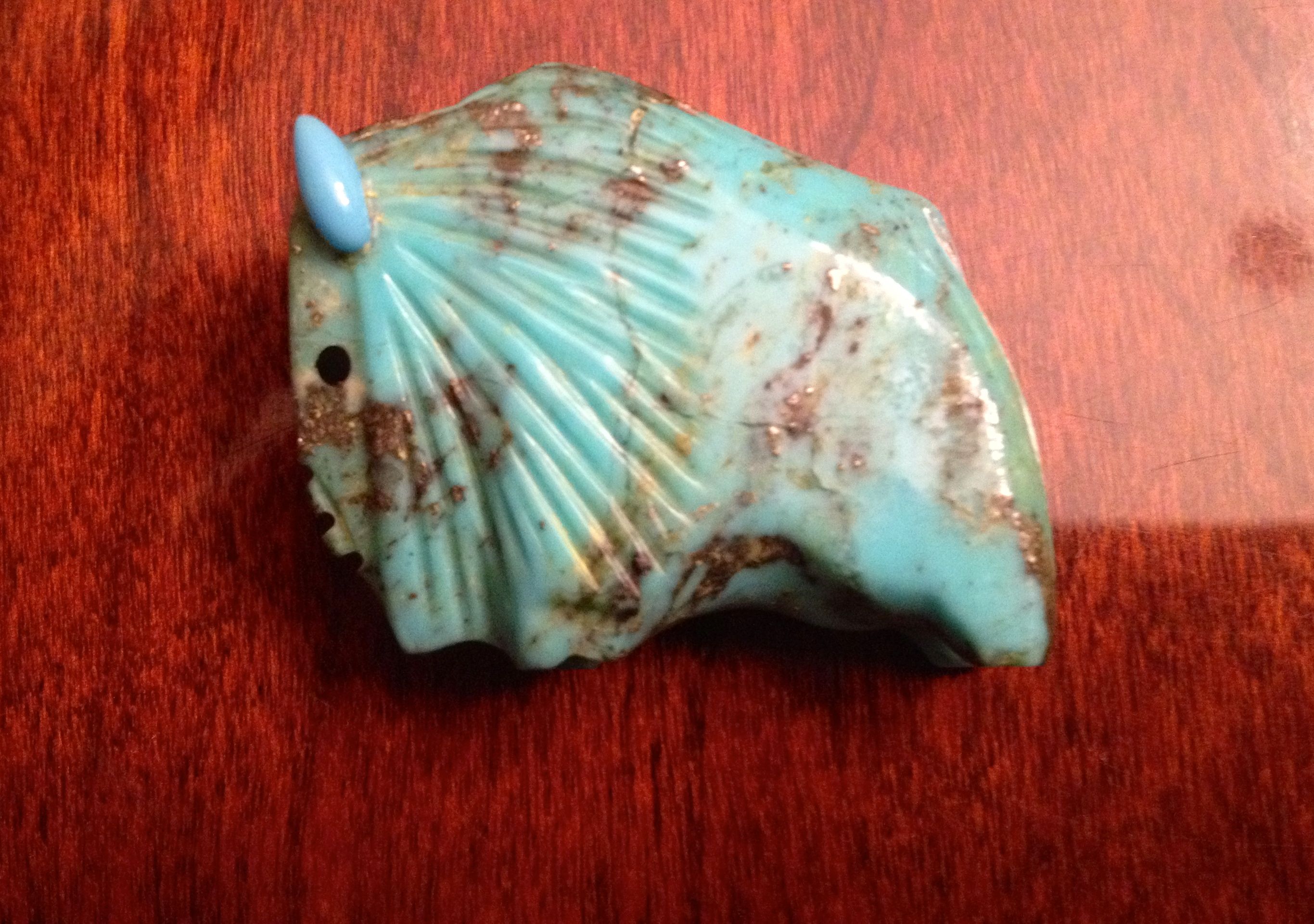
A lucky charm.
Notable Things I Decided Not to Bring
trekking poles: more trouble than they’re worth, I decided Post-race note: I did not need or want poles during the first three stages, but on the long stage and on Stage 5, I really wished I had poles. The loose rock on the steep terrain made the footing very difficult to navigate without poles. In hindsight, I wish I had brought my poles and carries them folded in my pack for the first three stages, and then used them in Stages 4 and 5.
gaiters: ditto, and I don’t want to fuss with them or have them trap heat and inhibit access to my shoelaces Post-race note: I did not regret this choice; gaiters were not necessary.
GPS watch: without the ability to recharge it unless I carried a solar-powered recharger (and I don’t want to add that weight), and with GPS tracking prohibited (to keep the exact route unpublished), I am simply wearing an old Timex Ironman stopwatch
Final Thoughts
I think that’s it! I’m ready and savoring these days in Hawaii with Morgan, trying not to over-indulge on good island food and beer.
I can’t wait to unplug and have a truly adventurous week! I re-read this Trail Runner essay I wrote in 2014 to remind myself why I’m doing this. Does this kind of week appeal to you, too?
Thanks for reading this! If you’d like to show your support, please learn about and donate to Free To Run.

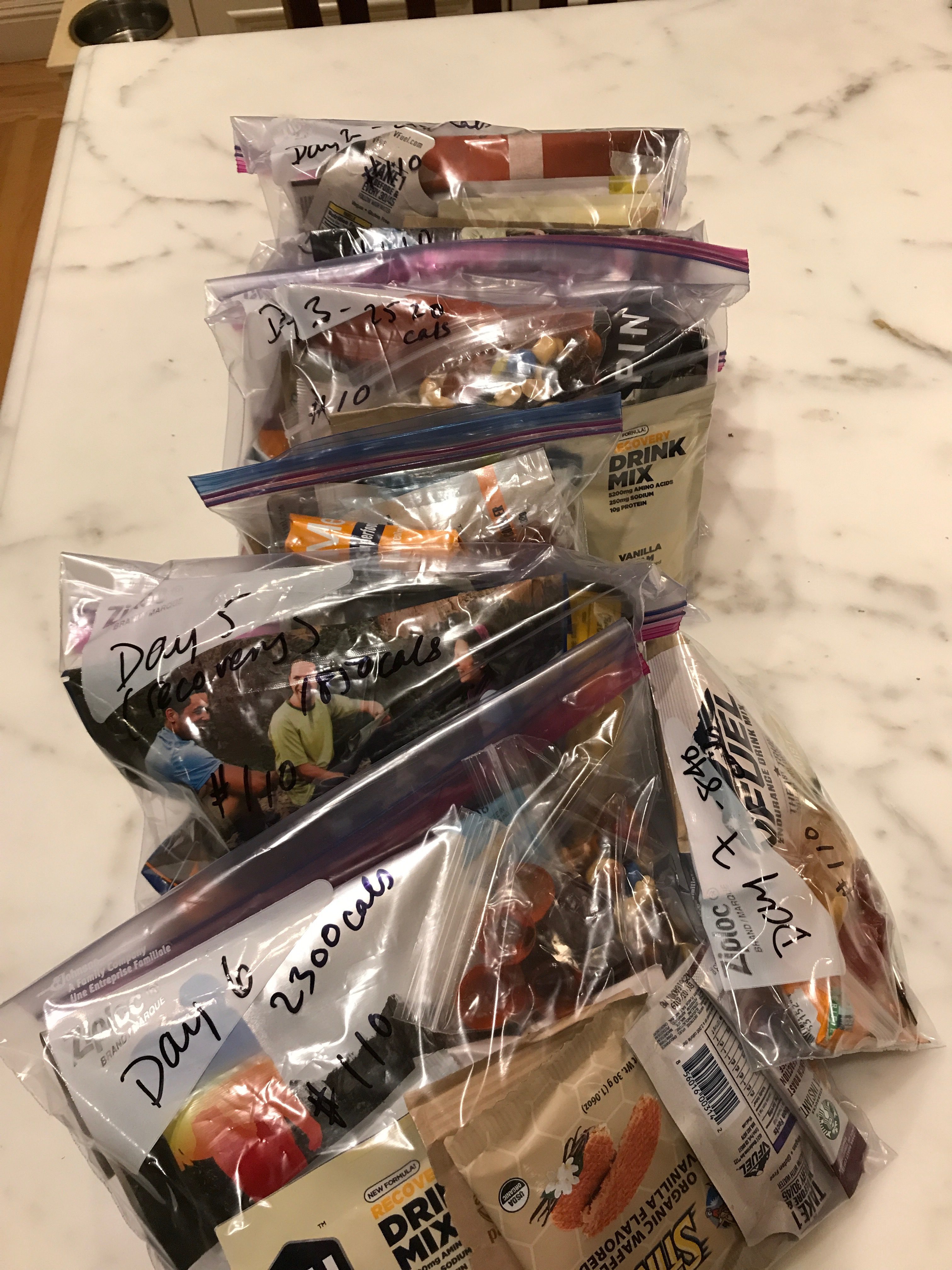
This looks so fu%#ing Spartan! What a grueling way to experience the ‘aina, but I’m glad the buffalo is coming along!
We’ll be thinking of you as you run through our former island home (I did part of your route on horseback with a guy named Dick Solomsen–a classical guitar playing, semi-retired Latin teacher at HPA). I hope you enjoy the varied topography and climate zones as much as I did.
Be safe and run hard (and get in some beach time down at Hapuna for us!).
–David
Great stuff, thanks for sharing. I appreciate the detail! I’m just getting into and experimenting with fastpacking, and hope to try some stage racing at some point- so this is very useful information.